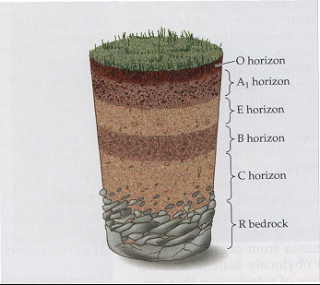DEFINITION PEDOSPHERE AND SOIL STRUCTURE
Definition
pedosphere, Soil Forming Factors, Concept Pedon and Soil Profile, Soil
Structure, Soil Classification, Some Kind of Soil, Soil and Its Impact Damage
also for life. These points will be described in Science Lovers blog in this
post with the theme pedosphere (soil). May be beneficial to all my friends.
A. DEFINITIONS
PEDOSPHERE
Pedosphere is the
uppermost layer of the earth's surface where the process of soil formation.
Simply put pedosphere can be interpreted as a layer of soil that occupies the
uppermost part of the lithosphere (the outermost layer of the Earth's crust
called wrappers sengai earth). Land is a natural form which formed from a
mixture of rock weathering results (inorganic), organic, water, and air that
occupies the top of the lithosphere. The study of land called pedology, while
the science that specifically learn about the process of soil formation called
pedogenesa.
B. FACTORS
DETERMINING FACTORS LAND
1. Climate and
climatic factors, which include weather and precipitation.
2. Organisms
(vegetation, microorganisms), the organism influence on soil formation
processes such as:
- Making the process of weathering
- Assist in the formation of humus
- The influence of vegetation on soil
properties, as seen in the temperate regions such as Europe and America
- Contains chemical elements found in plants
that affect soil properties.
3. Volcanic rocks,
igneous, sediment, and metamorphic rocks. All of these rocks can be called by
the parent material.
4. Relief Circumstances
(Topography), Circumstances Relief region will affect a thick or thin layer of
soil.
5. The time, the
soil is alan objects are constantly changing, as a result of weathering and
leaching continuously.
C. CONCEPT PEDON AND
PROFILE OF LAND
1. Pedon
Pedon is the
smallest volume that can be called the land and has the three-dimensional
measurement. Pedon wide range between 1-10 m square. Pedon collection of
Pedon-called polipedon. Polipedon wide minimum 2 sq m, while the maximum area
is not limited.
2. Soil Profile
The soil profile or
vertical cross section of land is a field of a side Pedon that characterize a
layers of soil, or (Horizon Land). Each soil horizon show the difference,
according to both chemical composition and physical. Most horizon can be
distinguished from the base color. Differences in soil horizon formed due to
two factors: the precipitation repeated by a puddle of water or soil leaching
(leached) and because the process of soil formation. The process of formation
of horizons that will generate new natural objects called ground. Horizons that
make up the soil profile in succession from top to bottom is the horizon O, A,
B, C, and D or R (BRF Rock).
D. STRUCTURE OF LAND
Soil structure is
small clumps of soil due to soil grains sticking to one another. Soil structure
has a different shape is as follows.
Plate (Platy), is found in the horizon A.
Prisma (Prosmatic), is found in the Horizon
B in dry climate areas.
Pole (Columnar) found in horizon B in dry
climate areas.
Angled glob (Angular Blocky) found in
horizon B in the wet climate.
Rounded glob (Sub Angular Blocky) found in
horizon B in a wet climate areas.
Granular (Granular) found in horizon A.
Crumb (Crumb), found on the horizon A.
E. TEXTURE SOIL
Soil texture rough
and smooth ground shows that based on the comparison of the number of grains
Padir, dust and clay in the soil. To determine soil texture, there are 12
classes in terms of three soil texture.
F. CLASSIFICATION OF
LAND
Soil classification
system (naturally) that exist in the world is composed of various kinds. For
many countries that use the classification system developed by the country
itself. Soil class name by affixing said sol is an abbreviation of the Latin
word solum. As is solum is the effective depth of soil that can still be
reached by the roots of plants.
G. SOME TYPES OF
SOIL
1. Peat / Land
Organosol
Organosol soil is
less fertile soil type to grow crops, the soil is the result of weathering
formation marsh plants.
2. Soil Sediment /
Soil Alluvial
Alluvial soil is
soil that is formed from river silt that settles in the low-lying nature of the
land has fertile and suitable for agriculture.
3. Land laterite
Laterite soil is not
fertile soil that was fertile and rich in nutrients, but nutrients are lost due
to late rains brought by the high water.
H. DAMAGE TO LAND
AND ITS IMPACT FOR LIFE
Soil degradation is
happening today is the impact of uncontrolled use of the environment, which
causes an environmental crisis. The impact of which is felt in human life is
the reduction of arable land which makes the depletion of land that can be used
as the location of production agricultural needs (matters relating to
agriculture) human.
Well a few of our posts about the science of
soil, Thank you my friend had wanted to visit and spend the time to read the
article in walyeducation.blogspot.com. If there is still something is up about
science in this article, immediately wrote on the fill in the comment box. Do
not forget also to divide up ya!

















